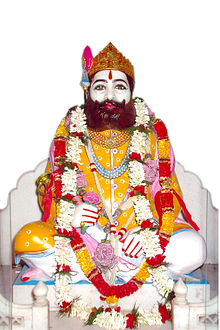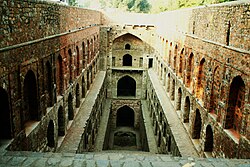1 OCT MAHARAJA AGRASEN
Agrasen
From Wikipedia, the free encyclopedia
| Agrasen | |
|---|---|
| Maharaja | |

Maharaja Agrasen
| |
| Predecessor | Maharaja Vallabh |
| Successor | Vibhu |
| Consort | Maharani Madhavi |
| Issue | Vibhu |
| Dynasty | Solar Dynasty |
| Father | Maharaja Vallabh |
| Mother | Bagwati Devi |
| Religion | Hinduism |
Agrasen was a legendary Indian king (Maharaja) of Agroha, a city of traders. The Agrawal and Agrahari communities claim descent from him. He is credited with the establishment of a kingdom of traders in North India named Agroha, and is known for his compassion in refusing to slaughter animals in yajnas.
The Government of India issued a postage stamp in honour of Maharaja Agresen in 1976.[1]
Contents
[hide]Origin of the legend[edit]
The Maharaja Agrasen legend can be traced to Agarwalon ki Utpatti ("Origin of the Agrawals"), an 1871 essay written by Bharatendu Harishchandra (1850-1885), a noted Agrawal author and poet. He claimed to have compiled the legend from "tradition" and "ancient writings", especially a text called Sri Mahalakshmi Vrat Ki Katha. He stated that Sri Mahalakshmi Vrat Ki Katha was contained in the Bhavishya Purana, which exists in several recensions. However, independent researchers have been unable to find the legend in any version of Bhavishya Purana.[4]
In 1976, the Agrawal historian Satyaketu Vidyalankar published a copy of the Mahalakshmi Vrat Ki Katha in his Agrwal Jati Ka Prachin Itihas ("Ancient History of the Agrawal caste"). He stated that he had found this copy in the personal library of Bharatendu Harishchandra. However, the text does not contain any clue about its origin.[4]
Legends and beliefs[edit]
Maharaja Agrasen was a vysya king of the Solar Dynasty who adopted Vanika dharma for the benefit of his people.[5][6] Literally, Agrawal means the "children of Agrasen" or the "people of Ag", a city in ancient Kuru Panchala, near Hisar in Haryana region said to be founded by Maharaja Agrasen.[7]
According to Bharatendu Harishchandra's account, Maharaja Agrasen was a Suryavanshi Kshatriya king, born during the last stages of Dwapar Yuga in the Mahabharat epic era, he was contemporaneous to Lord Krishna. He was a descendant of Suryavanshi King Mandhata. King Mandhata had two sons, Gunadhi and Mohan. Agrasen was the eldest son of the King Vallabh, descendant of Mohan, of Pratapnagar. Maharaja Agrasen fathered 18 children, from whom the Agrawal gotras came into being.
Maharaja Agrasen attended the swayamvara of Madhavi, the daughter of the King Nagaraj Kumud. However, Indra, the God of Heaven and also the lord of storms and rainfall, wanted to marry Madhavi, but she chose Agrasen as her husband. A furious Indra decided to take revenge by making sure that Pratapnagar did not receive any rain. As a result, a famine struck Agrasen's kingdom, who then decided to wage a war against Indra. Sage Naradawas approached by Indra, who mediated peace between Agrasen and Indra. As per the advice of Rishi Mahrishi Garg, he also married Sundaravati to increase his wealth and health.
He is said to have married 17 naga-kanyas.[8]
Another belief states King Agrasen to be the elder brother of Shoorsen Vrishni and elder grand father of Balarama and Krishna Vrishni of Mahabharata, descendant of King Yayati of Khandavprastha. It was built after several attacks faced from Jarasandha of Magadha Kingdom in Mahabharata period. Agroha was called as Agreya in its original period. King Agrasen made it capital of his state, a city in ancient Kuru Panchala, while his younger bother Shoorsen including Balarama and Shri Krishna decided to stay at Dvārakā.
Penance[edit]
Maharaja Agrasen started a severe (penance) to propitiate Shiva in the city of Agroha . Shiva pleased with the penance and advised him to propitiate Goddess . Maharaja Agrasen again started meditating on Mahalakshmi, who appeared before him and blessed him. She urged Agrasen (who was a Kshatriya) to start the Vaishya community for the tradition of business for the prosperity of his people. She asked him to establish a new kingdom, and promised that she would bless his descendants with prosperity. She also said there would not be any lack of wealth in his kingdom.
Agroha[edit]
Main article: Agroha (town)
Maharaja Agrasen traveled all over India with his queen to select a place for a new kingdom. At one point during his travels, he found a few tiger cubs and wolf cubs playing together. To King Agrasen and Queen Madhavi, this was an auspicious indication that the area was veerabhoomi (land of the brave) and they decided to found their new kingdom at that location. The place was named Agroha. Agroha is situated near present day Hisar in Haryana. Presently Agroha is developing as agrawal's holy station, having a Big Temple of Maharaja Agrasen & Vaishnav Devi.
Under the leadership of Maharaja Agrasen, Agroha became very prosperous. Legend has it that a hundred thousand traders lived in the city at its heyday. An immigrant wishing to settle in the city would be given a rupee and a brick by each of the inhabitants of the city. Thus, he would have a hundred thousand bricks to build a house for himself, and a hundred thousand rupees to start a new business.
Agrahari[edit]
Main article: Agrahari
Agrahari a community found in North India. They are descendant of Maharaja Agrasen.
Agrawal gotras[edit]
Main article: Agrawal
Maharaja Agrasen divided his kingdom among his 18 children, resulting in eighteen Agrawal gotras. Often, the number of gotras is stated to be seventeen. [5] Another version suggests that Maharaja Agrasen proceeded to conduct 18 mahayajnas ("Great yajnas"). During one such yajna, Agrasen noticed that a horse that had been brought to be sacrificed was trying hard to get away from the sacrificial altar. Seeing this Maharaj Agrasen was filled with compassion for the animal. The idea of ahimsa (non-violence) grabbed his mind. Therefore, he put a brake to his eighteenth yajna, announcing that no sacrifices will be made in his kingdom in name of yajnas. Thus, the eighteenth yajna wasn't completed and Maharaja Agrasen had performed seventeen and a half yajnas. The gods appeared before him and blessed him with seventeen and a half gotras.[9]
In the later part of his life, Maharaja Agrasen nominated his eldest son Vibhu to the throne and took up the Vanaprastha ashram. Gradually, the city of Agroha declined and was finally destroyed in a huge fire. The residents of Agroha i.e. the Agrawals moved out of Agroha and spread in other parts of India.
It is believed that King Agrasen married Madhavi, daughter of King Kumud of Nagaloka (Snake Kingdom). Thus Agrawals are the progeny of Madhavi and that is why they worship Nagas (snakes) and consider them to be their maternal uncles.
Following are the seventeen and a half gotras of Agrawals:
- Garg
- Goyal
- Goyan
- Bansal
- Kansal
- Singhal
- Mangal
- Jindal
- Tingal
- Aeron
- Dharan
- Madhukul
- Bindal
- Mittal
- Tayal
- Bhandal
- Kuchchal
- Nangal
Search Results
Maharaja Agrasen Gatha - YouTube
https://www.youtube.com/watch?v=cEIQPiAbTss
Apr 13, 2013 - Uploaded by अमित कुमार राघव
Maharaja Agrasen Gatha ... Maharaja agrsen Gaurav gatha By Sanjay navin ... any contact detail for ...MAHARAJA AGRASEN ke jivan par adharit film Ek Eint Ek Rupya MD ...
https://www.youtube.com/watch?v=3R48f51T-bo
Nov 8, 2011 - Uploaded by Fantastic Videos
MAHARAJA AGRASEN ke jivan par adharit film Ek Eint Ek Rupya . This Movie is based on the life of ...Agrasen maharaj ji ka bhajan - YouTube
https://www.youtube.com/watch?v=qaddAMn3PTk
Oct 4, 2012 - Uploaded by Sanjay Agrawal
ANY BODY CAN CONTACT ME FOR MORE BHAJAN OF SHRI AGRASEN JI singing mixing and lyrics-sanjay ...Maharaja Agrasen Ji Ki Aarti - Agrawalsabha.com - YouTube
https://www.youtube.com/watch?v=jhstnyJMTTY
Sep 3, 2011 - Uploaded by Mayank Agrawal
Maharaja Agrasen Ji Ki Aarti - Agrawalsabha.com ... Agrasen ji ke Jaikare Bhajan | Agrasen Ji ...Maharaja Agrasen Gatha - YouTube
https://www.youtube.com/watch?v=Q_YMriBYyes
Jan 7, 2014 - Uploaded by Vaish Bharat
Maharaja Agrasen Gatha ... 1:06:29. MAHARAJA AGRASEN ke jivan par adharit film Ek Eint Ek Rupya ...Agrasen maharaj ji ka bhajan 2 - YouTube
https://www.youtube.com/watch?v=zAldE654sZA
Oct 10, 2012 - Uploaded by Sanjay Agrawal
ANY BODY CAN CONTACT ME FOR MORE BHAJAN OF SHRI AGRASEN JI Lyrics, Singing and Mixing ...Jai Jai Agrasen Maharaj - Popular Aarti in Hindi with Lyrics - YouTube
https://www.youtube.com/watch?v=hvHKS6wB9Ns
Jul 4, 2011 - Uploaded by bhaktisongs
Watch Jai Jai Agrasen Maharaj a soft and melodious aarti sung in devotion and praise of Lord Agrasen. For ...Sri Agrasen Maharaj Full Story | Shri Agrasen Maharaj Gatha - YouTube
https://www.youtube.com/watch?v=xlUvZyzzfhw
Oct 11, 2015 - Uploaded by Bhakti Sagar AR Entertainments
Shri Agrasen Maharaj Story in Bhajan Agrasen was a vysya king of the Solar Dynasty who adopted Vanika ...Shree Maharaja Agrasen Jayanti Part 8 - YouTube
https://www.youtube.com/watch?v=FJcZfShnIQ4
Feb 2, 2013 - Uploaded by Vinzul Satish
Shree Maharaja Agrasen Jayanti & Navratri Mahotsav at Tagor Hall ( Ahmedabad ) Organized By ...Maharaja Agrasen " INDIAN NAVY SHIP " - YouTube
https://www.youtube.com/watch?v=YOLl6LAwAuo
Sep 20, 2010 - Uploaded by AKDRocks
Maharaja Agrasen " INDIAN NAVY SHIP " ... We are following ideals ofMaharaja Agrasen ...
Stay up to date on results for maharaja agrasen.
Create alertSearch Results
Agrasen - Wikipedia, the free encyclopedia
https://en.wikipedia.org/wiki/Agrasen
Agrasen was a legendary Indian king (Maharaja) of Agroha, a city of traders. The Agrawal and Agrahari communities claim descent from him. He is credited with the establishment of a kingdom of traders in North India named Agroha, and is known for his compassion in refusing to slaughter animals in yajnas.
Father: Maharaja Vallabh
Mother: Bagwati Devi
Dynasty: Solar Dynasty == Heading text ==
Religion: Hinduism
In the news
Amrik Singh Road renamed as Maharaja Agrasen Road
Chandigarh Tribune - 11 hours ago
PM Modi Wishes Nation On Agrasen Jayanti
More news for maharaja agrasen
NDTV - 22 hours ago
Maharaja Agrasen Bhavan (House): Buildings in GHATKOPAR EAST ...
places.wonobo.com/mumbai/maharaja-agrasen-bhavan-(house)/647521
Maharaja Agrasen Bhavan (House): Buildings in GHATKOPAR EAST,Mumbai - information | contact details | reviews | images | rating | near by.MAHARAJA AGRASEN - Crude Oil Tanker - Details and current ...
www.vesselfinder.com › Vessels › Tankers
Vessel details for: MAHARAJA AGRASEN (Crude Oil Tanker) - IMO ...
https://www.marinetraffic.com/se/ais/details/.../vessel:MAHARAJA%20AGRASEN
Aug 7, 2016 - Vessel details: MAHARAJA AGRASEN. Discover the vessel's basic Details, including the vessel IMO / vessel MMSI and vessel Call Sign.Maharaja Agrasen Vidhyalaya
agrasenvidyalaya.ac.in/
Recognized as the best English Medium CBSE School in Ahmedabad, Gujarat. India's leading school in curriculum, syllabus and overall child development.
about maharaj agrasen --- Agarwal Community
www.agarwalcommunity.com/about-agrasen-maharaj.php
Translate this page
Maharaja Agrasen is known as icon of non-violence , messenger of Peace, Maharaja Agrasen was an embodiment of Sacrifice, Compassion, Non-Violence,Maharaja Agrasen College of Engineering & Technology is affiliated to ...
www.agrasencollege.ac.in/
Maharaja Agrasen College of Engineering & Technology is affiliated to Dr. A.P.J. Abdul Kalam Technical University and is approved by the All India Council for ...MAHARAJA AGRASEN ke jivan par adharit film Ek Eint Ek Rupya MD ...
https://www.youtube.com/watch?v=3R48f51T-bo
Nov 8, 2011 - Uploaded by Fantastic Videos
MAHARAJA AGRASEN ke jivan par adharit film Ek Eint Ek Rupya . This Movie is based on the life of ...Searches related to maharaja agrasen
Dahisar West, Mumbai, Maharashtra - From your search history - Use precise location

Thanks for sharing this info.To see your board's date sheet, click on the link given below
ReplyDeleteGujarat SSC Date Sheet 2018
Haryana Board 10th Date Sheet 2018
Haryana Board 12th Date Sheet 2018
HP Board 10th Date Sheet 2018
Jharkhand Board 10th Date Sheet 2018
Jharkhand Board 12th Date Sheet 2018